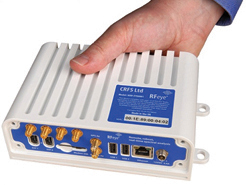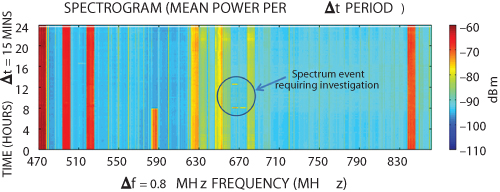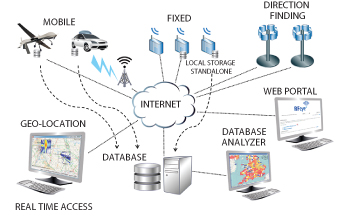 CRFS saw a gap in the market and set out to create a new type of spectrum intelligence system, combining the best features of benchtop spectrum analyzers and high performance SIGINT systems in a neat ruggedized package that is very fast, simple to deploy and infinitely scalable – so the RFeye® was born. The philosophy of CRFS was to create a single “little white box” with built-in intelligence that is capable of performing a whole series of tasks usually reserved for multiple different specialist systems – multi-user, multi-mission. At the outset, all the potential applications for the RFeye were not fully known, so CRFS designed it to be as flexible and versatile as possible with an architecture that allows easy overlay of new functionality.
CRFS saw a gap in the market and set out to create a new type of spectrum intelligence system, combining the best features of benchtop spectrum analyzers and high performance SIGINT systems in a neat ruggedized package that is very fast, simple to deploy and infinitely scalable – so the RFeye® was born. The philosophy of CRFS was to create a single “little white box” with built-in intelligence that is capable of performing a whole series of tasks usually reserved for multiple different specialist systems – multi-user, multi-mission. At the outset, all the potential applications for the RFeye were not fully known, so CRFS designed it to be as flexible and versatile as possible with an architecture that allows easy overlay of new functionality.
The RFeye is a radio receiver, spectrum sensor, interference detector, direction finding system, signal demodulator and security system, all rolled into one. The unit runs fast with 10 MHz to 6 GHz spectrum sweeps in less than 100 ms – allowing it to capture and analyze even short-burst transmissions or the most transient spectrum events (see Figure 1). The high performance radio is coupled with a Linux baseband so the unit can operate fully autonomously without the need for a computer server.

Figure 1 Example spectrogram from RFeye system.
One of the unique benefits is how very large networks of RFeye nodes can be deployed (see Figure 2), each with its own remote distributed computing power. The fact that each node is intelligent means that it is able to act independently, process and analyze data, make decisions based on its programming, and communicate with and assign tasks to any other nodes in the network, all without the need to refer back to the center. This allows the whole system to run superfast – no data backhaul problems, no routing via a central server – making it ideal for dynamic real-time applications. The RFeye can simply be connected to an IP address and directly queried from any location.

Figure 2 RFeye system diagram.
The RFeye can be programmed remotely to perform a series of multi-layered missions with relative priorities assigned to each. These include general background monitoring and spectrum occupancy measurements, interference detection, transmitter geo-location, signal demodulation and classification. The idea is that a network of nodes is deployed – fixed or temporary – around a particular geographic area of interest. That could be a sensitive building like an embassy or state department, a city center, a sports stadium, a military proving ground, a critical installation like a power plant, a harbor, coastline or land border – whatever needs to be monitored. The RFeye makes measurements of the spectrum to provide information about both authorized and unauthorized activity in the area – real-time intelligence that can be acted upon – for example to resolve interference, reassign frequencies, share spectrum between different users, detect intruders or bugging devices, whatever. The system architecture is designed to allow multiple users to access the network simultaneously and request multiple different missions and operations.
The RFeye nodes are all synchronized to a reference clock – either GPS for outdoors or CRFS’s proprietary SyncLinc system for in-building – so that each node in the network sweeps at exactly the same time. Background masks are created for authorized or expected RF activity at the node – any detected signal that breaks the mask can trigger the RFeye to perform a closer investigation, sound an alarm, as appropriate, and send commands to the nearest nodes in the network to locate the source using various techniques like time difference of arrival (TDOA), power on arrival (POA) or angle of arrival (AOA). The fact that it has such good RF performance and exceptionally low internal spurious elements means that the RFeye can reliably detect and locate even low power signals.
The RFeye is packaged in a ruggedized aluminium housing rated to IP67, fits in the palm of a hand and weighs less than 5 lbs. It is a low-power unit and can be powered from multiple sources including battery-backed solar cells. There is also a lightweight, extra low-power rack-mountable Vita format version of the RFeye, suitable for integration with other sensors.
CRFS supplies not only the white boxes, but also a whole range of
RFeye systems including backpacks, storm cases and roof boxes for portable and mobile use, as well as radome systems with built-in DF arrays for fixed mounting and vehicle mounting. The company also has a first-class application software team that works with customers, partners and integrators, to provide full turnkey solutions.
CRFS has recently launched a frequency extender for the RFeye – the BDC-18. The BDC-18 extends the range of the RFeye to 18 GHz which opens up a range of interesting new applications for customers who wish to monitor higher as well as lower frequencies, particularly in the military and non-civilian sectors. The BDC provides a simple and seamless extension of the RFeye making it suitable both for new installations and retrofit. A key advantage is the ability to mount the unit right next to the 18 GHz antennas, thus alleviating the problem of high cable losses at these frequencies.
The architecture of the BDC has been designed to ensure that the exceptional RF performance and speed of the RFeye is maintained up to the higher frequencies. Several of CRFS’s customers would like to monitor and manage all frequencies “from DC to light.” CRFS’s latest development program is a BDC-50 based on the same technology which will further extend the range up to 50 GHz and is planned for launch by the end of 2012.
CRFS Inc.,
Yucaipa, CA
(949) 413-1024,
www.crfs.com
